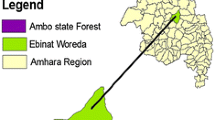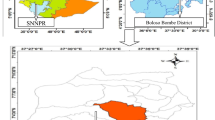Abstract
To investigate the woody species composition, diversity and structure of Kuandisha Afromontane forest, vegetation and environmental data were collected from 53 plots of 10 m × 50 m for trees and shrubs and 265 subplots of 2 m × 4 m for seedlings were laid along eight transect lines. The local name, scientific name, abundance, DBH, height and percentage foliage cover of species were recorded. Environmental variables, namely altitude, latitude and longitude as well as disturbance levels were also recorded in each plot. Structure, basal area, importance value index (IVI) and species prioritization were analyzed using spreadsheet programs. Correlation coefficients, frequency, relative frequency, Shannon diversity index, Shannon evenness and vegetation classification were analyzed using an R package. Sixty-six species belonging to 40 families were recorded. Fabaceae was the most diverse family consisting of seven species, followed by Euphorbiaceae and Asteraceae. In terms of habit, 29 species were trees, 28 were shrubs, and 9 were lianas. The overall Shannon diversity index was 2.5. The frequency and relative frequency of woody species with DBH ≥2.5 cm ranged from 1.9 to 92.5 and 0.1 to 5, respectively. Seedling density varied among species ranging from five to 9938 individuals ha−1. The total basal area of woody species having DBH ≥2.5 cm is 15.3 m2 ha−1. The IVI of species ranged from 0.13 for Solanum giganteum Jacq. to 28.4 for Croton macrostachyus Del. The woody vegetation was classified into five community types. Species richness, diversity and evenness of communities were strongly positively correlated. On the other hand, the correlation between disturbance and seedling density, and species richness was strongly negative. Thus, among the recorded woody species, a significant portion was either lacking regeneration or selectively removed for various purposes. The lack of seedlings of those species is mainly attributed to anthropogenic disturbances particularly free grazing. As a result, 14 tree, seven shrub and one liana species were prioritized for conservation and management interventions.







Similar content being viewed by others
References
Alelign A, Teketay D, Yemshaw Y, Edwards S (2007) Diversity and status of regeneration of woody plants on the Peninsula of Zegie, northwestern Ethiopia. Trop Ecol 48(1):37–49
Awas T, Bekele T, Demissew S (2001) An ecological study of the vegetation of Gambella region, southwestern Ethiopia. SINET 24(2):213–228
Ayalew A (2003) A floristic composition and structural analysis of the Denkoro Forest, south Wello. MSc Thesis, Addis Ababa University, Addis Ababa pp 1–92
Bamps P (1989) Araliaceae. In: Hedberg I, Edwards S (eds) Flora of Ethiopia and Eritrea (vol. 3): Pittosporaceae to Araliaceae. The National Herbarium, Addis Ababa, pp 532–547
Bantiwalu S (2010) Floristic composition, structure and regeneration status of plant species in Sanka Meda Forest, Guna District, Arsi Zone of Oromia Region, Southeast Ethiopia. M.Sc. Thesis. Addis Ababa University, Addis Ababa pp 1–117
Beche D (2011) Floristic composition, diversity and structure of woody plant species in Menagesha Suba State Forest, Central Ethiopia. MSc. Thesis. Addis Ababa University, Addis Ababa pp 1–61
Bekele T (1993) Vegetation ecology of remnant Afromontane forests on the central plateau of Shewa, Ethiopia. Ph.D. Dissertation, Opulus press, Uppsala pp 1–64
Bekele T (2005) Recruitment, survival and growth of Olea europaea subsp. cuspidata seedlings and juveniles in dry Afromontane forests of northern Ethiopia. Trop Ecol 46(1):113–126
Bekele T, Haase H, Soromessa T (1999) Forest genetic resources of Ethiopia: status and proposed actions. In: Edwards S, Demissie A, Bekele T, Haase G (eds) Proceedings of Forest Genetic Resources Conservation: principles, strategies and actions. Institute of Biodiversity Conservation and Research, Addis Ababa, pp 49–72
Brown JH, Lomolino MV (1998) Biogeography, 2nd edn. Courier Companies, Sunderland, pp 1–704
Dalle G (2015) Floristic composition, population structure and conservation status of woody species in Shashemene-Munessa Natural Forest, Ethiopia. Ethiop J Biodivers 1(1):21–44
Dalle G, Fetene M (2004) Gap-fillers in Munessa-Shashemene forest. Ethiop J Biol Sci 3:1–14
DCR-DNH (2011) Outline of procedures for data collection using the standard DCR-DNH plot form. Virginia Department of Conservation and Recreation/Division of Natural Heritage, Richmond, pp 1–15
Demissew S, Friis I (2009) Natural vegetation of the flora area. In: Hedberg I, Friis I, Persson E (eds) Flora of Ethiopia and Eritrea (vol. 8). General part and index to volumes 1–7. The National Herbarium, Addis Ababa, pp 27–32
Edwards S, Demissew S, Tadesse M, Hedberg I (1995) Flora of Ethiopia and Eritrea (vol. 2:1): Magnoliaceae to Flacourtiaceae. The National Herbarium, Addis Ababa, pp 1–532
Edwards S, Demissew S, Hedberg I (1997) Flora of Ethiopia and Eritrea (vol. 6): Hydrocharitaceae to Arecaceae. The National Herbarium, Addis Ababa, pp 1–586
Friis I (2009) Cupressaceae. In: Hedberg I, Friis I, Persson E (eds) Flora of Ethiopia and Eritrea (vol. 1): Lycopodiaceae to Pinaceae. The National Herbarium, Addis Ababa, pp 193–199
Friis I, Demissew S, Breugel PV (2010) Atlas of the potential vegetation of Ethiopia. The Royal Danish Acadamy of Sciences and Letters (Natural habitats), Addis Ababa, pp 1–307
Gemechu D (1977) Aspects of climate and water budget in Ethiopia. Addis Ababa University, Addis Ababa, pp 1–71
Gilbert MG (1995) Euphorbiaceae. In: Edwards S, Tadesse M, Hedberg I (eds) Flora of Ethiopia and Eritrea (vol. 2–2): Canellaceae to Euphorbiaceae. The National Herbarium, Addis Ababa, pp 265–380
Green P (2003) Oleaceae. In: Hedberg I, Edwards S, Nemomissa S (eds) Flora of Ethiopia and Eritrea (vol. 4–1): Apiaceae to Dipsacaceae. The National Herbarium, Addis Ababa, pp 79–87
GSE (2010) Geology of Ethiopia. Ethiopian Ministry of Mines and Geological Survey of Ethiopia, Addis Ababa, pp 1–3
GTZ (2003) Forest Inventory report for Zege Peninsula, Kibran Gebriel and Daga Estifanos monasteries, Lake Tana. Addis GTZ/IBCR Forest Genetic Resources Conservation Project, Institute of Biodiversity Conservation and Research, Ababa, pp 1–24
Hedberg I (1989) Rosaceae. In: Hedberg I, Edwards S (eds) Flora of Ethiopia and Eritrea (vol 3): Pittosporaceae to Araliaceae. The National Herbarium, Addis Ababa, pp 31–45
Hedberg I, Edwards S, Nemomissa S. 2003. Flora of Ethiopia and Eritrea (vol 4–1): Apiaceae to Dipsacaceae. Addis Ababa and Uppsala: The National Herbarium, p. 1-352
Hedberg I, Kelbessa E, Edwards S, Demissew S, Persson E (2006) Flora of Ethiopia and Eritrea (vol. 5): Gentianaceae to Cyclocheilaceae. The National Herbarium, Addis Ababa, pp 1–690
Hedberg I, Friis I, Persson E (2009a) Flora of Ethiopia and Eritrea (vol. 1): Lycopodiaceae to Pinaceae. The National Herbarium, Addis Ababa, pp 1–305
Hedberg I, Friis I, Persson E (2009b) Flora of Ethiopia and Eritrea. General part and index to volumes 1–7 (vol. 8). The National Herbarium, Addis Ababa, pp 1–331
Kent M, Coker P (1992) Vegetation description and analysis. A practical approach. Wiley, New York, pp 1–363
Kharkwal GP, Mehrotra P, Rawat YS, Pangtey YPS (2007) Phytodiversity and growth form in relation to altitudinal gradient in the central Himalayan (Kumaun) region of India. Curr Sci 89(5):873–878
Krebs CJ (1999) Ecological methodology. Addison Wiseley Longman, New York, pp 1–694
Laurance WF (2008) Theory meets reality: how habitat fragmentation research has transcended Island Biogeographic Theory. Biol Conserv 141:1731–1744
Laurance WF, Ferreira LV, Merona JM, Laurance SG (1998) Rain forest fragmentation and the dynamics of Amazonian tree communities. Ecology 79(6):2032–2040
Laurance WF, Camargo WFJ, Luizão RCC, Laurance SG, Pimmd SL, Bruna EM, Stouffer PC, Williamson GB, Benítez-Malvido J, Vasconcelos HL, Houtan KSV, Zartman CE, Boyle SA, Didhamm RK, Andrade A, Lovejoy TE (2010) The fate of Amazonian forest fragments: a 32-year investigation. Biol Conserv 44(1):56–67
Leeuwenberg AJM (2003) Apocynaceae. In: Hedberg I, Edwards S, Nemomissa S (eds) Flora of Ethiopia and Eritrea (vol 4–1): Apiaceae to Dipsacaceae. The National Herbarium, Addis Ababa, pp 87–98
Maguran AE (1988) Ecological diversity and its measurement. Princeton University Press, Princeton, pp 1–177
Maria EJ, Miquel R, Javier R (1995) Patterns of seedling recruitment in West-Mediterranean Quercus ilex forests influenced by canopy development. J Veg Sci 6:465–472
Økland RH (1990) Vegetation ecology: theory, methods and application with reference to Fennoscandia. University of Oslo, Oslo, pp 1–233 Sommerfeltia Suppl
Oksanen J, Blanchet FG, Kindt R, Legendre P, Minchin PR, O’Hara RB, Simpson GL, Solymos P, Henry M, Stevens H, Wagner H (2014) Vegan: community ecology package. R package version 2.0-7. http://CRAN.R-project.org/package=vegan
R Core Team (2014) R: a language and environment for statistical computing. R foundation for Statistical Computing, Vienna. http://www.R-project.org
Scheibler D, Schneider W (1985) Monte CarRo tests of the accuracy of cluster analysis algorithms: a comparison of hierarchical and nonhierarchical methods. Multivar Behav Res 20:283–304
Singh W (2008) Robustness of three hierarchical agglomerative clustering techniques for ecological data. MSc. Thesis. University of Iceland, Reykjavik pp 1–100
Stirling G, Wilsey B (2001) Empirical relationships between species richness, evenness, and proportional diversity. Am Nat 158(3):286–299
Tadele D, Lulekal E, Damtie D, Assefa A (2014) Floristic diversity and regeneration status of woody plants in Zengena forest, a remnant montane forest patch in northwestern Ethiopia. J For Res 25(2):329–336
Tadesse M (2004) Asteraceae (Compositae). In: Hedberg I, Friis I, Edwards S (eds) Flora of Ethiopia and Eritrea, vol (vol 4–2). The National Herbarium, Addis Ababa, pp 1–408
Teketay D (2005a) Seed and regeneration ecology in dry Afromontane forests of Ethiopia: I. Seed production—population structures. J Trop Ecol 46(1):29–44
Teketay D (2005b) Seed and regeneration ecology in dry Afromontane forests of Ethiopia: II. Forest disturbances and succession. J Trop Ecol 46(1):45–64
Teketay D, Bekele T (1995) Floristic composition of Wof-Washa natural forest, central Ethiopia: implications for the conservation of biodiversity. Feddes Repert 106:127–147
Tesfaye G, Berhanu A (2006) Regeneration of indigenous woody species in the understory of exotic tree plantations in southwestern Ethiopia. Ethiop J Biol Sci 5(1):31–43
Vollesen K (1995) Sterculiaceae. In: Edwards S, Tadesse M, Hedberg I (eds) Flora of Ethiopia and Eritrea (vol 2–2): Canellaceae to Euphorbiaceae. The National Herbarium, Addis Ababa, pp 165–185
Wassie A, Teketay D, Powell N (2005) Church forests in north Gonder administrative zone, northern Ethiopia. For Trees Livelihoods 15:349–373
Wassie A, Sterck FJ, Teketay D, Bongers F (2009) Effects of livestock exclusion on tree regeneration in Church forests of Ethiopia. For Ecol Manag 257:765–772
Woldu Z (1999) Forests in the vegetation types of Ethiopia and their status in the geographical context. In: Edwards S, Demissie A, Bekele T, Haase G (eds) forest genetic resources conservation: principles, strategies and actions. Proceedings of the National Forest Genetic Resources Conservation Strategy Development Workshop. Institute of Biodiversity Conservation and Research, Addis Ababa, pp 1–38
Woldu Z (2014) Comprehensive analysis of vegetation and ecological data: concepts and methods. Addis Ababa University Press, Addis Ababa, pp 1–386
Yalden DW (1983) The extent of high ground in Ethiopia compared to the rest of Africa. SINET 6:35–39
Yineger H, Kelbessa E, Bekele T, Lulekal E (2008) Floristic composition and structure of the dry Afromontane forest at Bale Mountains National Park, Ethiopia. SINET 31(2):103–120
Zegeye H, Teketay D, Kelbessa E (2011) Diversity and regeneration status of woody species in Tara Gedam and Abebaye forests, northwestern Ethiopia. J For Res 22(3):315–328
Zewdie A (2007) Comparative floristic study on Menagesha Suba state forest on years 1980 and 2006. M.Sc. Thesis. Addis Ababa University, Addis Ababa, pp 1–88
Acknowledgments
We thank the Dangila Wereda Agricultural Bureau staff and Kuandisha District Administration. All field assistants (particularly Mr. Demissew Taye and Tewodros Misganaw) and local people are duly acknowledged. The anonymous reviewers are gratefully acknowledged for their corrections, constructive comments and suggestions. The research was fully funded by the Ethiopian Biodiversity Institute, Community Based Integrated Natural Resources Management (CBINRM) project grant.
Author information
Authors and Affiliations
Corresponding author
Additional information
The online version is available at http://www.springerlink.com
Corresponding editor: Zhu Hong
Electronic supplementary material
Below is the link to the electronic supplementary material.
Rights and permissions
About this article
Cite this article
Berhanu, A., Demissew, S., Woldu, Z. et al. Woody species composition and structure of Kuandisha afromontane forest fragment in northwestern Ethiopia. J. For. Res. 28, 343–355 (2017). https://doi.org/10.1007/s11676-016-0329-8
Received:
Accepted:
Published:
Issue Date:
DOI: https://doi.org/10.1007/s11676-016-0329-8




